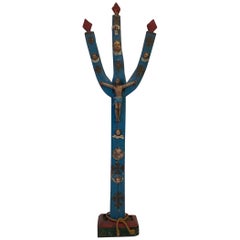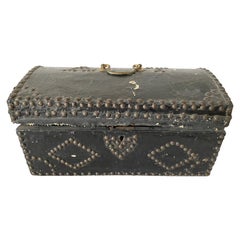Want more images or videos?
Request additional images or videos from the seller
1 of 10
19th Century Retablo, St. Isidro Painted on Tin, in Original Embossed Tin Frame
Price:$650
$695List Price
About the Item
- Dimensions:Height: 20 in (50.8 cm)Width: 11 in (27.94 cm)Depth: 0.13 in (3.31 mm)
- Style:Spanish Colonial (Of the Period)
- Materials and Techniques:Tin,Embossed
- Place of Origin:
- Period:
- Date of Manufacture:1850-1890
- Condition:Wear consistent with age and use. This lovely piece, in highly distressed condition, is still extremely charming and visually moving. The faded colors, the multiple losses of paint inside a frame of missed parts, remains remarkably attractive for devotees of Spanish Colonial imagery.
- Seller Location:Van Nuys, CA
- Reference Number:1stDibs: LU920711680811
About the Seller
4.5
Vetted Professional Seller
Every seller passes strict standards for authenticity and reliability
1stDibs seller since 2011
68 sales on 1stDibs
Authenticity Guarantee
In the unlikely event there’s an issue with an item’s authenticity, contact us within 1 year for a full refund. DetailsMoney-Back Guarantee
If your item is not as described, is damaged in transit, or does not arrive, contact us within 7 days for a full refund. Details24-Hour Cancellation
You have a 24-hour grace period in which to reconsider your purchase, with no questions asked.Vetted Professional Sellers
Our world-class sellers must adhere to strict standards for service and quality, maintaining the integrity of our listings.Price-Match Guarantee
If you find that a seller listed the same item for a lower price elsewhere, we’ll match it.Trusted Global Delivery
Our best-in-class carrier network provides specialized shipping options worldwide, including custom delivery.You May Also Like
Santa Rita Retablo
Located in Santa Monica, CA
This late 19th century Mexican Folk Art devotional painting depicts St. Rita of Casia, the patron saint of lost and improbable causes.
Wishing to join an Augustinian convent ...
Category
Antique 19th Century Mexican Spanish Colonial Religious Items
Materials
Tin
19thc Retablo Catholic Framed Art
Located in Los Angeles, CA
A Retablo is a devotional painting, especially a small popular or folk art one using iconography derived from traditional Catholic church art. Depicting a Saint and a child painted o...
Category
Antique Mid-19th Century American Adirondack Paintings
Materials
Tin
Antique 19th Century Oil on Tin Painting ''Two Nudes in Nature''
Located in Braintree, GB
Antique 19th-century oil on tin painting '' Two nudes in nature ''
Dimensions:
Picture size: 11 x 8.5 x 8.5 cm
Weight: 118 grams
Condition: Pa...
Category
Antique 19th Century European Paintings
Materials
Wood
$4,064
Free Shipping
H 3.35 in W 4.34 in D 0.12 in
19th C. Mexican Retablo "Veronica's Veil", c.1880
Located in San Francisco, CA
About
An original 19th century Mexican folk retablo "Veronica's Veil" or "El Divono Rostro" in Spain . Oil paint on tin.
The Veil of Veronica, known in Italian as the Volto Santo or Holy Face, is a Roman Catholic Relic which, according to legend, bears the likeness of the Face of Jesus that was imprinted on it prior to Jesus' crucifixion. According to Roman Catholicism, Saint Veronica encountered Jesus in Jeruselum on the way to Calvary. When she paused to wipe the sweat (Latin, suda) off his face with her veil, his image was left on the veil.
In the small village of Osa de la Vega in Spain, there lived a couple who led a very pious life. They were Gregorio de la Torre and Isabel Corral. From their father, Juan Montilla, they inherited a picture of the Face of Jesus or the Divino Rostro. A story that is told one day, to the amazement of many who confirmed its veracity, the picture began to perspire with living blood. News of this extraordinary event spread swiftly and widely throughout the land.
CREATOR Unknown.
DATE OF MANUFACTURE c.1880.
MATERIALS AND TECHNIQUES Oil Paint on Tin.
CONDITION Good. Wear consistent with age and use.
DIMENSIONS H 14 in. W 10 in.
HISTORY
Retablos, better known as 'laminas' in Mexico, are small oil paintings on tin, wood and sometimes copper which were used in home altars to venerate the almost infinite number of Catholic saints. The literal translation for 'retablo' is 'behind the altar.' This unique genre of art, deeply rooted in European history, was brought to Mexico with the arrival of the Spanish and then ultimately adopted by New World mestizo natives to become what is known today as the Mexican folk retablo.
The retablo was an art form that flourished in post conquest Mexico and then ultimately, with the introduction of inexpensive mediums such as tin, reached its pinnacle of popularity in the last quarter of the 19th century. With some exceptions, mostly untrained artists from the provinces worked to produce and reproduce these sacred images; some subjects painted more prolifically than others. A typical "retablero" may have reproduced the same image hundreds, if not thousands of times in his or her career.
These oil paintings were sold to devout believers who displayed them in home altars to honor their patron saints. There are virtually hundreds of saints, each invoked to remedy a different situation. "San Ysidro Labrador," the patron saint of farmers, is venerated for good weather...
Category
Antique 19th Century Mexican Folk Art Paintings
Materials
Tin
19th c. Mexican Retablo "Veronica's Veil" c.1880
Located in San Francisco, CA
ABOUT
An original 19th century Mexican folk retablo "Veronica's Veil" or "El Divono Rostro" in Spain . Oil paint on tin.
The Veil of Veronica, known in Italian as the Volto Santo or Holy Face, is a Roman Catholic Relic which, according to legend, bears the likeness of the Face of Jesus that was imprinted on it prior to Jesus' crucifixion. According to Roman Catholicism, Saint Veronica encountered Jesus in Jeruselum on the way to Calvary. When she paused to wipe the sweat (Latin, suda) off his face with her veil, his image was left on the veil.
In the small village of Osa de la Vega in Spain, there lived a couple who led a very pious life. They were Gregorio de la Torre and Isabel Corral. From their father, Juan Montilla, they inherited a picture of the Face of Jesus or the Divino Rostro. A story that is told one day, to the amazement of many who confirmed its veracity, the picture began to perspire with living blood. News of this extraordinary event spread swiftly and widely throughout the land.
CREATOR Unknown.
DATE OF MANUFACTURE c.1880.
MATERIALS AND TECHNIQUES Oil Paint on Tin.
CONDITION Good. Wear consistent with age and use.
DIMENSIONS H 14 in. W 10 in.
HISTORY
Retablos, better known as 'laminas' in Mexico, are small oil paintings on tin, wood and sometimes copper which were used in home altars to venerate the almost infinite number of Catholic saints. The literal translation for 'retablo' is 'behind the altar.' This unique genre of art, deeply rooted in European history, was brought to Mexico with the arrival of the Spanish and then ultimately adopted by New World mestizo natives to become what is known today as the Mexican folk retablo.
The retablo was an art form that flourished in post conquest Mexico and then ultimately, with the introduction of inexpensive mediums such as tin, reached its pinnacle of popularity in the last quarter of the 19th century. With some exceptions, mostly untrained artists from the provinces worked to produce and reproduce these sacred images; some subjects painted more prolifically than others. A typical "retablero" may have reproduced the same image hundreds, if not thousands of times in his or her career.
These oil paintings were sold to devout believers who displayed them in home altars to honor their patron saints. There are virtually hundreds of saints, each invoked to remedy a different situation. "San Ysidro Labrador," the patron saint of farmers, is venerated for good weather...
Category
Antique 19th Century Mexican Folk Art Paintings
Materials
Tin
Antique Late 19th Century Seascape Lighthouse Oil Painting
Located in Hyattsville, MD
Unsigned Maritime oil painting. Very good quality, by the hand of a professional painter. The painting is soiled from 100 years of exposure. The frame has some losses (chips) to the ...
Category
Antique 19th Century American American Classical Paintings
Materials
Wood
$556 Sale Price
20% Off
H 18.25 in W 14.25 in D 3.24 in
19th Century Oil On Tin Bird of Pray Golden Eagle
Located in Lowestoft, GB
A charming and well executed oil on tin depiction of a golden eagle perched on a rock face with a pleasing pallet of pink and yellow.
19th century in age, housed in it original oval...
Category
Antique 19th Century European Paintings
Materials
Pine
Spanish hand painted Retablo Art
Located in Los Angeles, CA
A Retablo is a devotional painting, especially a small popular or folk art one using iconography derived from traditional Catholic church art. Depicting a Saint and a child painted o...
Category
Antique Mid-19th Century American Adirondack Paintings
Materials
Tin
19th Century Original Oil Painting of Nobleman
Located in Scottsdale, AZ
19th Century Original Oil Painting of Nobleman. Striking piece with age appropriate wear, see condition details below. Most likely English but could be French with English frame. ...
Category
Antique 19th Century English Early Victorian Paintings
Materials
Canvas, Paint
19th C Framed Fraktur Watercolor Painting
Located in Los Angeles, CA
Beautiful 19th C Fruktur by Martha Geist
The poem on the Fruktur (watercolor) is re-written below.
"If my name heaven is my station, This world is my habitation.
Christ is my ...
Category
Antique 19th Century American Country Paintings
Materials
Wood
More From This Seller
View AllSpanish Colonial, Painted Wooden Crucifix of Christ on a Stylized Tree
Located in Van Nuys, CA
This carved wooden crucifix of Christ on a stylized tree form, is Guatemalan or Mexican, likely created in the late 1800s by a naive artist of the peri...
Category
Antique Late 19th Century Central American Spanish Colonial Sculptures a...
Materials
Wood
$1,200 Sale Price
39% Off
Blue Eyed Couple with Eye Glasses, Photo-Realistic 20th Century Oil Painting
Located in Van Nuys, CA
This representational double portrait of a couple is signed with initials "MN" in the lower left corner, by an unidentified artist.
It is a flat, washed out image, perhaps painted by...
Category
Vintage 1950s American Mid-Century Modern Paintings
Materials
Canvas, Oak
$495 Sale Price
52% Off
19th Century Leather Covered Box with a Domed Lid, Brass Handle and Hinges
Located in Van Nuys, CA
This small box for personal possessions (perhaps papers or letters), is covered in black leather and decorated with borders of brass tacks, including the letters A.T. on its lid, and...
Category
Antique Early 19th Century American Federal Historical Memorabilia
Materials
Brass
Unusual 20th Century Kachina "style" Doll of a Navajo Figure with Large Hands
Located in Van Nuys, CA
Painted cottonwood Kachina "style" doll depicting a Navajo, circa 1940s. It is in good condition, with bright color. Kachina dolls were usually created to teach Hopi children the var...
Category
Vintage 1940s American Native American Native American Objects
Materials
Wood
$360 Sale Price
20% Off
19th Century American Hooked Rug
Located in Van Nuys, CA
American hand hooked wool rug of brightly colored floral bouquet on oval, pale gray background, framed in black wool surround, with small floral ...
Category
Antique 19th Century American Aesthetic Movement Rugs
Materials
Burlap, Wool
19th Century wood Santos of a boy/child with glass eyes and articulated arms.
Located in Van Nuys, CA
This charming piece has been in my collection for over 40 years. The articulated arms and glass eyes contribute to its charm and personality. I have always felt it signified a sense ...
Category
Antique Late 19th Century Mexican Spanish Colonial Sculptures and Carvings
Materials
Fabric, Glass, Wood, Paint
Recently Viewed
View AllMore Ways To Browse
Antique Retablos
Retablo On Tin
Religious Retablos
Spanish Retablo
Spanish Colonial Retablos
Silver Milagros
Antique French Religious
Crucifix Antique
Religious Icon
Gothic Church
Antique Judaica
Antique Collectible Plates
Carved Wood Religious
Antique French Cross
American Colonial Furniture 18th Century
Sacred Heart
Italian Gothic
Christ Cross



